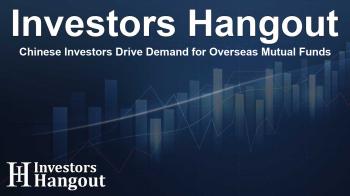Chinese Investors Drive Demand for Overseas Mutual Funds

Surge in Interest for International Investments
Chinese investors are increasingly turning to Hong Kong's mutual fund products as they seek better yields overseas. The fresh enthusiasm comes after authorities made significant alterations to a cross-border trading channel. These changes have opened new doors for investors, allowing them to explore more lucrative investment opportunities.
Record Sales of Funds
The appetite for Hong Kong mutual funds that invest abroad is evident, with several funds disappearing from the market within just 24 hours of their availability for subscriptions. This trend highlights a strong pent-up demand among Chinese investors who are looking for alternatives to the current limitations of domestic investment options.
Recent Regulatory Changes
Recently, some Hong Kong funds have been allowed to market their products to investors from mainland China. This was made possible by an adjustment in the Mutual Recognition of Funds (MRF) scheme, which significantly increased the sales quota for eligible funds. Previously capped at 50%, this limit has now risen to 80% of a fund's total assets.
Investor Preferences
The ongoing slump in domestic bond yields is driving this investment rush. As domestic yields are at historic lows, investors are keenly seeking higher yield options. Funds that emphasize overseas markets, particularly those focusing on U.S. Treasuries and various bonds, are experiencing heightened interest.
Success Stories in the Fund Market
Notable examples include two bond funds from JPMorgan, which promptly reached their subscription limits due to overwhelming demand. Furthermore, significant offerings from other firms, such as ChinaAMC and E Fund, sold out on their first day back after resuming subscriptions, underscoring the competitive landscape in this growing market.
Impact of Falling Yields
A noteworthy trend is the dramatic drop in yields on China's 10-year government bonds, which have plummeted over 100 basis points in just a year, settling below 1.6%. This scenario has widened the gap between Chinese bond yields and those of U.S. Treasuries, reaching a staggering 24-year high.
Future of Cross-Border Investments
The MRF scheme, initially established in 2015, has been somewhat limited by strict fundraising regulations. However, recent enhancements have sparked new interest, with over forty Hong Kong funds now participating in the program. By November, these funds had collectively raised 41.5 billion yuan, marking a substantial increase compared to previous figures.
New Players on the Scene
As the landscape evolves, even global firms, previously indifferent to the MRF, are beginning to engage with the scheme. This interest reflects the growing potential for attracting foreign investment and the opportunity to capitalize on the funds available to mainland investors.
Conclusion
With regulations shifting and investors eager for alternatives, the influx of capital into Hong Kong's mutual funds that invest internationally is likely to continue. The adjustments to the MRF scheme could herald a new era of investment opportunities for Chinese investors seeking favorable returns on their money.
Frequently Asked Questions
What are Hong Kong mutual funds?
Hong Kong mutual funds are investment products that pool money from various investors to purchase a diversified portfolio of assets, including stocks and bonds, often with a focus on international markets.
How have regulatory changes impacted investment flows?
Recent alterations to the regulations governing cross-border investments have allowed higher investment quotas, leading to increased demand for Hong Kong mutual funds among Chinese investors.
What types of assets are most popular among investors?
Chinese investors have shown a strong preference for funds focusing on U.S. Treasuries and other bond investments, driven by the pursuit of higher yields.
How does the yield discrepancy affect investments?
The widening gap between domestic bond yields and those of U.S. Treasuries makes international bonds more attractive as investors look for better returns with manageable risks.
What is the significance of the MRF scheme?
The Mutual Recognition of Funds scheme facilitates cross-border investment, making it easier for mainland Chinese investors to access Hong Kong funds, thus enhancing the overall appeal of overseas investments.
About Investors Hangout
Investors Hangout is a leading online stock forum for financial discussion and learning, offering a wide range of free tools and resources. It draws in traders of all levels, who exchange market knowledge, investigate trading tactics, and keep an eye on industry developments in real time. Featuring financial articles, stock message boards, quotes, charts, company profiles, and live news updates. Through cooperative learning and a wealth of informational resources, it helps users from novices creating their first portfolios to experts honing their techniques. Join Investors Hangout today: https://investorshangout.com/
Disclaimer: The content of this article is solely for general informational purposes only; it does not represent legal, financial, or investment advice. Investors Hangout does not offer financial advice; the author is not a licensed financial advisor. Consult a qualified advisor before making any financial or investment decisions based on this article. The author's interpretation of publicly available data presented here; as a result, they should not be taken as advice to purchase, sell, or hold any securities mentioned or any other investments. If any of the material offered here is inaccurate, please contact us for corrections.
